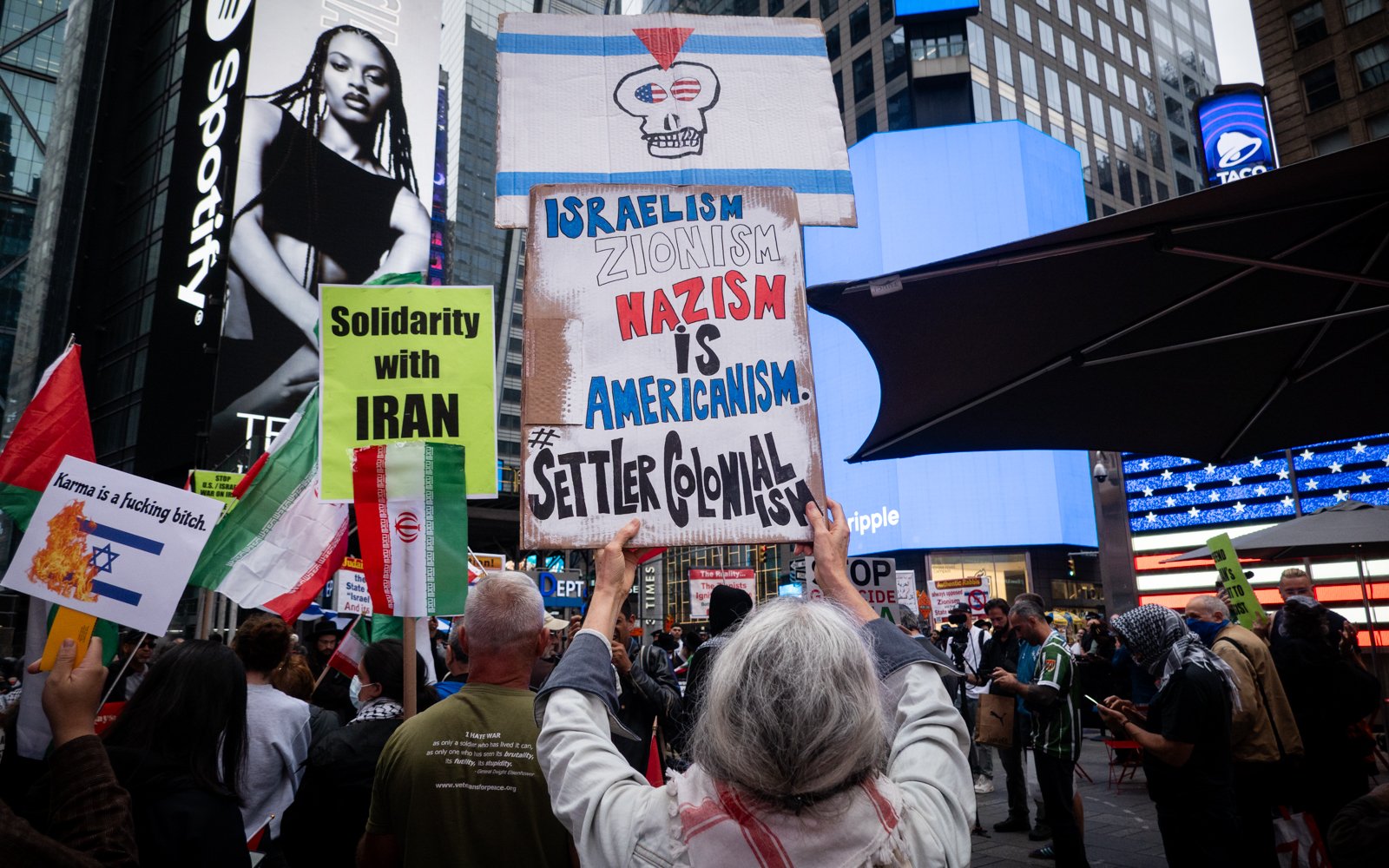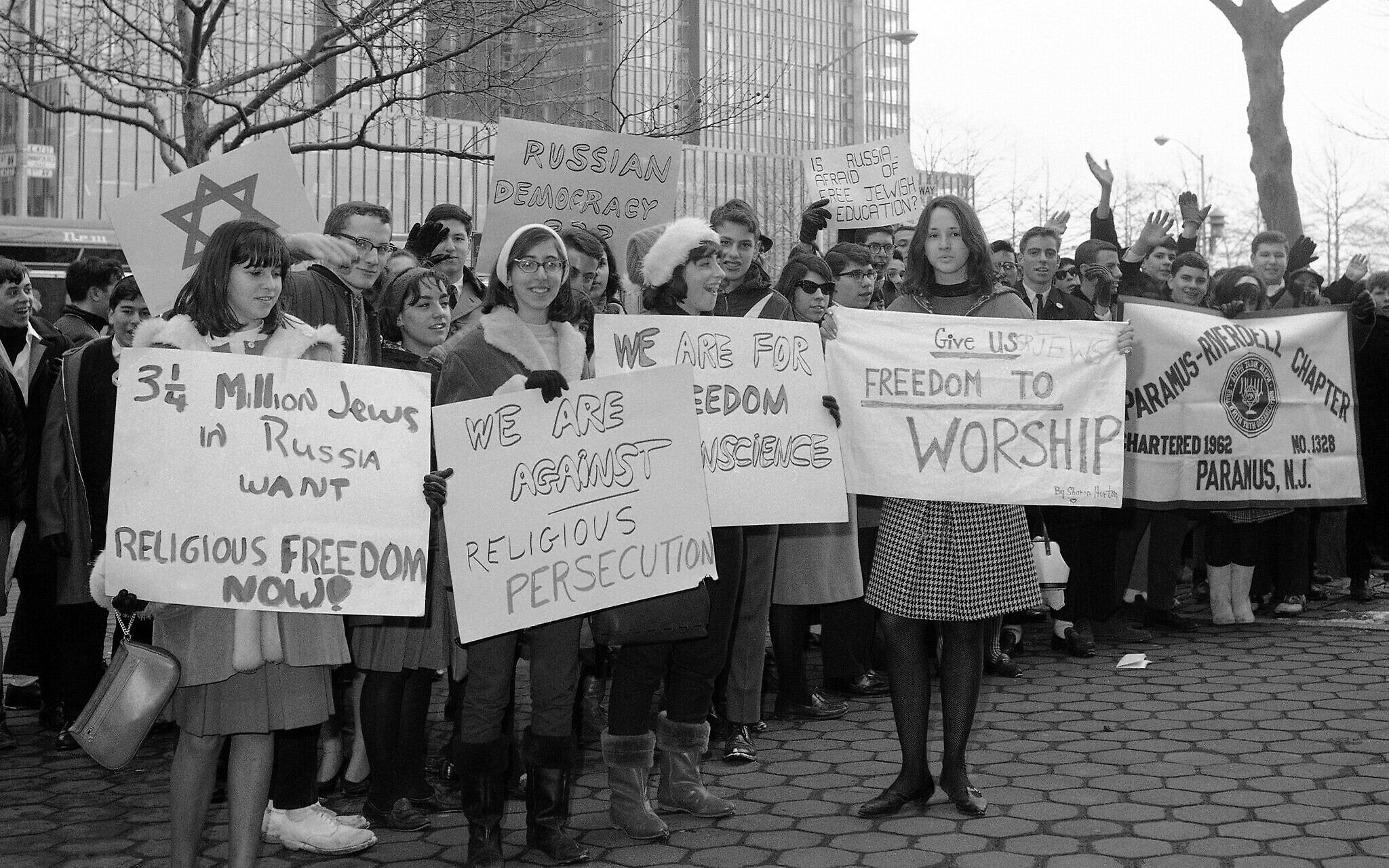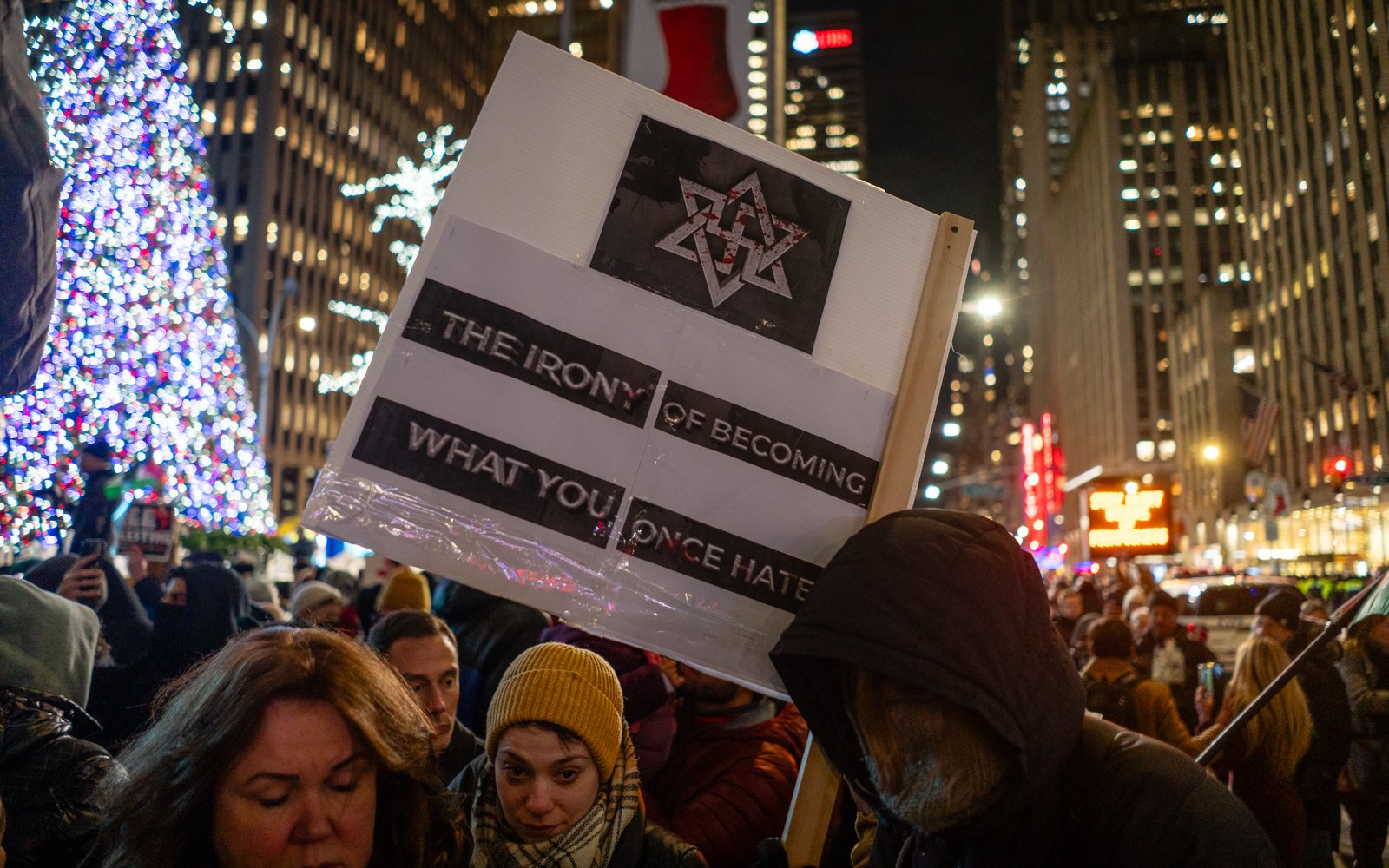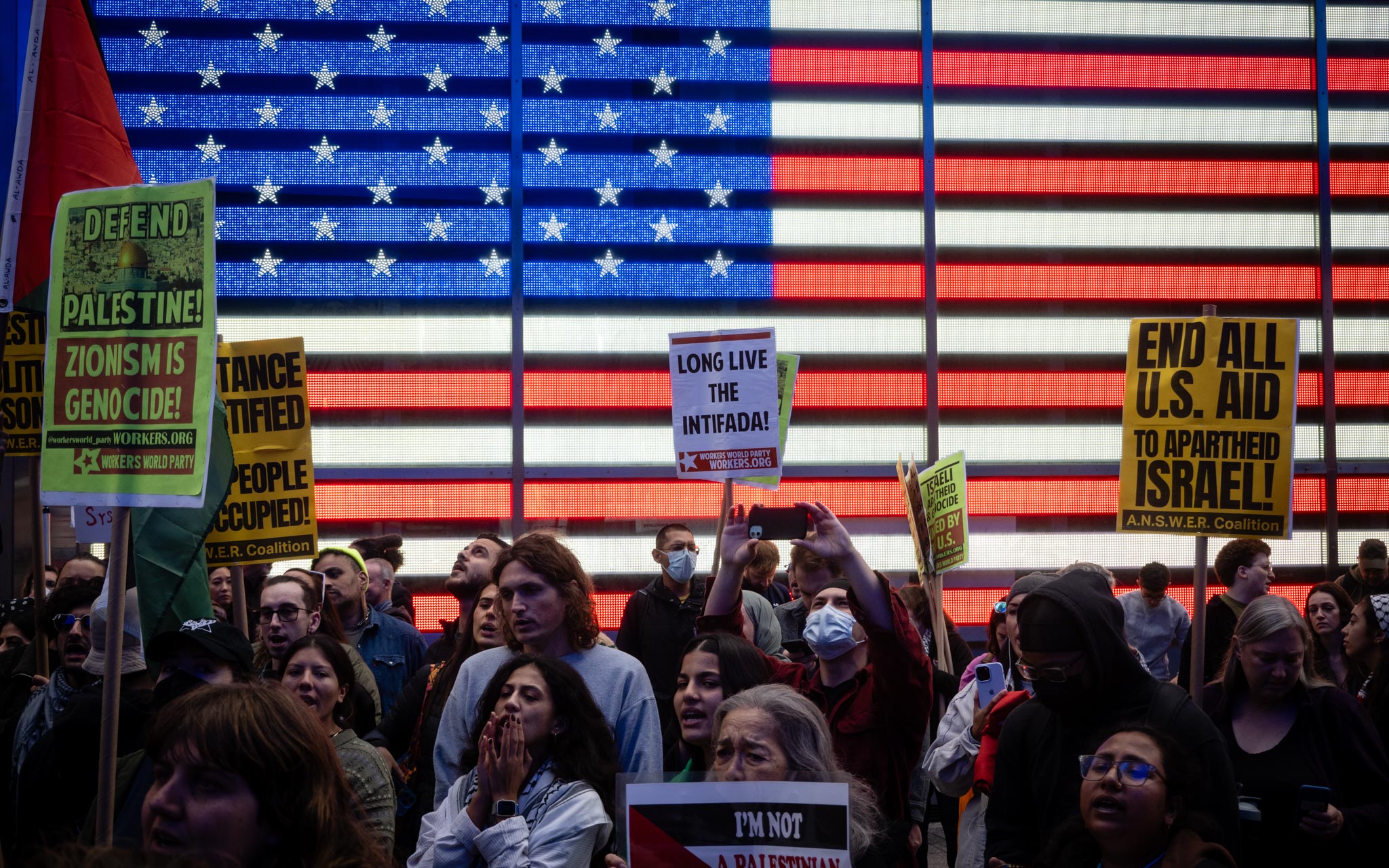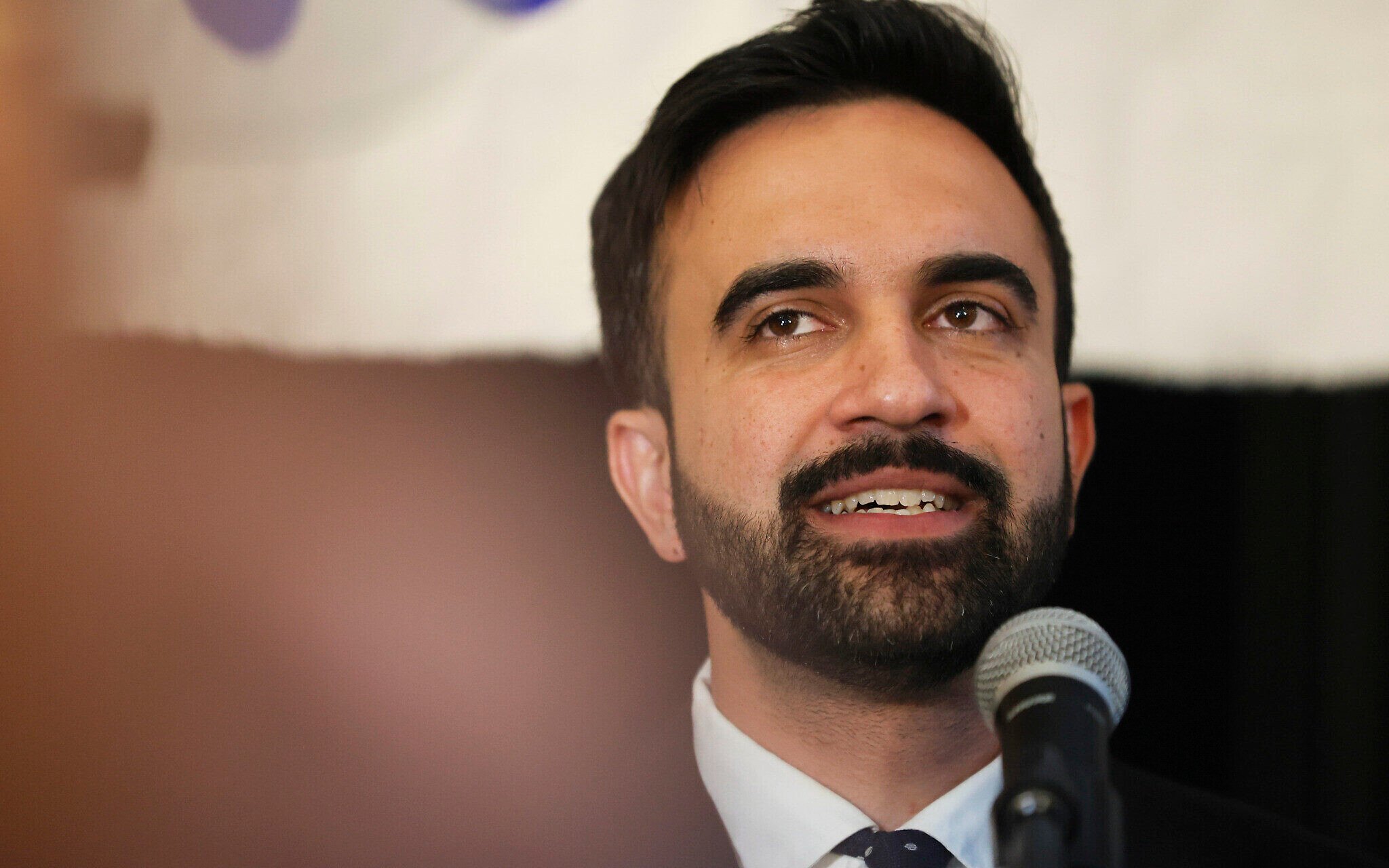


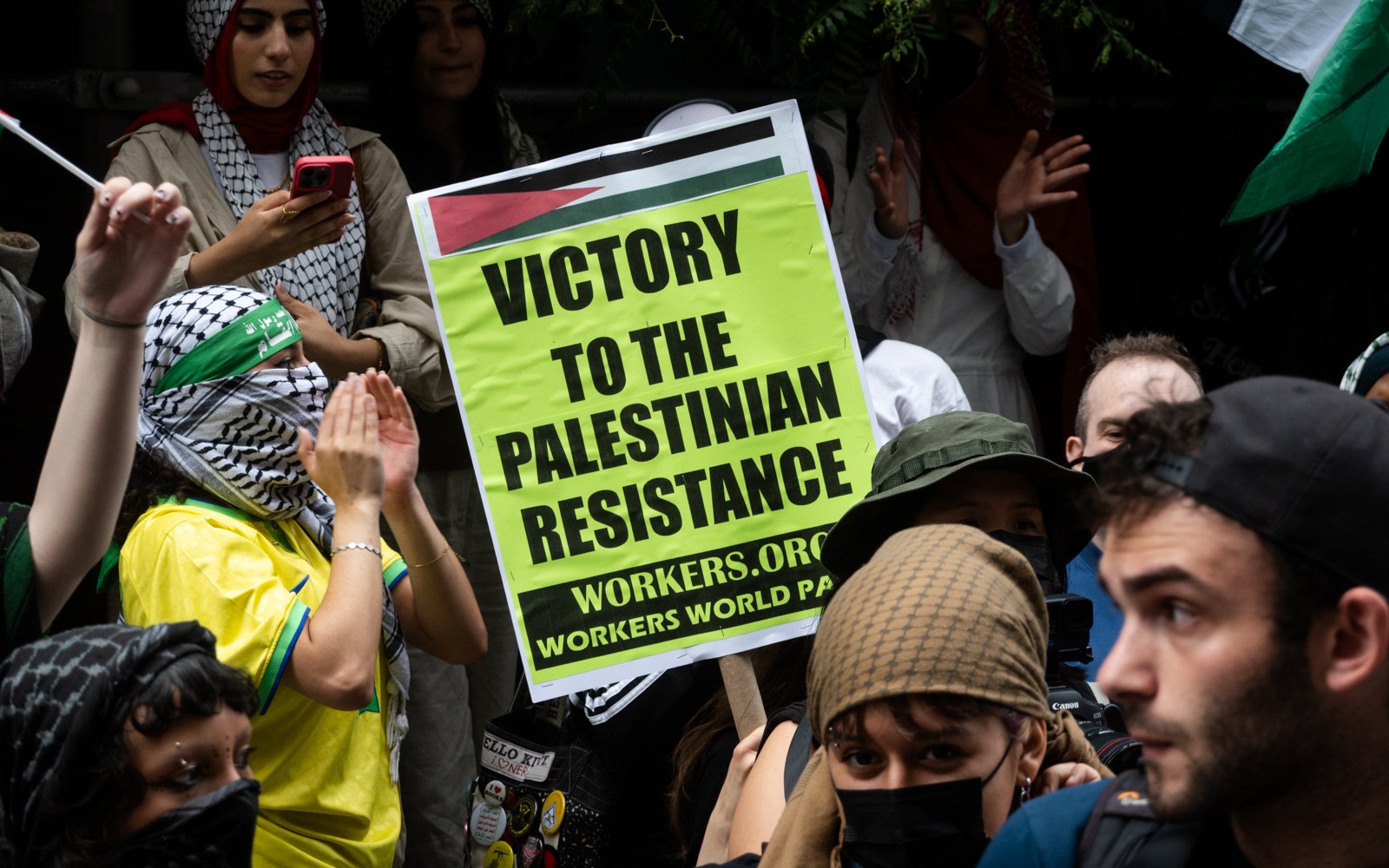
On October 8, 2023, hundreds gathered in New York City’s Times Square to celebrate the Hamas invasion of Israel. The crowd gathered beneath the plaza’s giant, illuminated American flag, chanting “Zionism has got to go” and mocking Jewish, pro-Israel counterprotesters.
Signs at the rally said, “Zionism is genocide,” “Colonialism is violence,” and “Anti-Zionism ≠ antisemitism.” Other placards accused Israel of “white supremacy” and apartheid, and decried US funding for Israel.
While the slogans surfaced in New York City in 2023, those sentiments have roots in the Soviet Union, according to Izabella Tabarovsky, a scholar of Soviet antisemitism.
“The Soviets were the ones who began to equate the Palestinians with partisans in World War II and the resistance and national liberation movements such as the ANC and the Viet Cong — heroes of the left — and painting them in that way, and making it possible for the left to connect with them,” Tabarovsky said.
The issue of far-left, socialist opposition to Israel gained new prominence last month with New York State Assemblyman Zohran Mamdani’s stunning win in the New York City Democratic party mayoral primary. Mamdani is a harsh critic of Israel and a member of the far-left Democratic Socialists of America, one of the groups that backed the October 8, 2023, Times Square rally. In his statement the same day, Mamdani blamed Israel and “apartheid” for the violence.
Part of Tabarovsky’s research delves into why the US far left is so committed to anti-Israel activism, even as there are more bloody conflicts and oppressive regimes around the world.
Tabarovsky, who is Jewish, grew up in the Soviet Union and emigrated to the US in 1989 at age 19. She received a Master’s degree in Russian history from Harvard University, and after her studies, continued working on Russia-related research. Currently, she is a senior fellow with the Z3 Institute for Jewish Priorities, a US think tank, and lives in Jerusalem.
Before her connection with Z3, she managed content on Russia at the Wilson Center, a prominent, nonpartisan foreign policy think tank in Washington, DC, until it was shuttered by the Trump administration earlier this year. She also coordinated the center’s US-Israel working group on Russia in the Middle East. Tabarovsky has worked with the Carnegie Endowment for International Peace, the London Centre for the Study of Contemporary Antisemitism, and Brandeis University. She has written extensively about topics including Russia, antisemitism and the war in Ukraine.
Around 2018, she saw a news story about an anti-Israel campus demonstration where protesters held signs that read “Zionism is racism” and “Israel is an apartheid state.” The slogans triggered memories of antisemitism in the USSR, where similar language was common.
“I immediately understood that this was language that we had heard back in the USSR. What I couldn’t understand was, why is it here in America now?” she said. “The language is so similar. It’s just really improbable that people here in the US have invented it from scratch.”
She began to dig and pieced together the story of Soviet anti-Zionism and how it filtered through the global left.
The story is complex and not limited to Soviet messaging. Anti-Israel scholars in the West and the Arab world had their own concepts of anti-Zionism that interacted with Soviet positions. The Soviets picked up some ideas from their Arab allies. Tabarovsky said the USSR, though, acted as “this big synthesizer that took in all of these ideas,” and “pumped this stuff out into the world.”
Moscow had been anti-Israel since the late 1940s, when Israel aligned with the USSR’s western enemies. The rhetoric took off after the 1967 Six-Day War, when Israel smashed the larger forces of the Soviet-backed Arab states, creating a crisis of confidence in Moscow. The USSR had invested vast sums in Egypt’s military.
“If you look at the Soviet press leading into the Six Day War, they were sure that the Arab states would win,” Tabarovsky said. “They’re so much bigger, and they have Soviet expertise and Soviet machinery, and then they lose. They didn’t understand the reasons behind it.”
The Soviet political culture and security services were prone to conspiracism, and, to explain Israel’s victory, looked to their Cold War enemy, the US. Washington was not backing Israel at the time, but the Soviets saw influential pro-Israel Jews and Jewish organizations involved in politics and the media. The view that foreign Jews were the enemy layered well onto longstanding antisemitic conspiracies.
The war also invigorated a Jewish national movement in the USSR that the state viewed as subversive. The Soviet Jews were supported by Jews in the US and other countries.
“To them, when they connect these dots, what are they seeing? They’re seeing that there are American Jews who are trying to undermine Soviet domestic politics by inflaming Jewish national sentiments, Jewish Zionist sentiments,” Tabarovsky said.
Americans tend to view developments through an economic prism, but for the Soviets, ideology was dominant. They came to view Zionism as an enemy ideology, focused on undermining it, and after 1967, “it really goes global,” Tabarovsky said.
Anti-Zionist Soviet propagandists released hundreds of books and thousands of articles, and peddled their messaging on the radio and via political cartoons. They funded conferences that convened third-world revolutionaries, including the PLO and Fatah, with Western intellectuals who brought the ideology home.
The propaganda linked Zionism to Nazism, fascism, racism, genocide, settler-colonialism, imperialism and apartheid. The Third World and socialist bloc, covering much of the world, turned against Israel and Zionism.
Months after the Six-Day War, for example, a Soviet front organization called the World Peace Council held a gathering in India that drew attendees from 55 countries in the West, the Third World and the Soviet bloc. A speaker told the crowd that the Arab-Israeli conflict should be understood as “imperialism and colonialism versus national liberation and social progress” — language that could come from a US socialist group today. Other motifs have reappeared, such as signs that intertwine a Star of David with a swastika, an image used in both Soviet propaganda and at anti-Israel protests in New York.
The United Nations was another key forum. Opposition to Israel was an easy route for non-aligned states to win support from the USSR or Arab countries. In 1975, the UN passed a resolution equating Zionism with racism, overseen by UN secretary-general Kurt Waldheim, a former Nazi who was involved in deporting Jews from Greece during the Holocaust and had attended a non-aligned anti-Zionist summit in Algiers in 1973.
After the Soviet Union collapsed, many of the Western activists went on to academic and political careers, passing on the ideology to future generations.
“It got this worldwide reach at that time, and it has existed on the far left since then. That’s how it had ended up in places like New York City today,” Tabarovsky said. “I think that for the far left today, they don’t even understand the causes, but for the far left today, I think the anti-Israel stance is just the default stance.”
David Bernstein, the author of the 2022 book “Woke Antisemitism” about anti-Jewish discrimination on the left, said Soviet propaganda had played a role in “empowering anti-Zionism.”
“It’s created and it’s linked anti-Zionism to the progressive ideology in a way that continues to affect us today,” said Bernstein, the head of the North American Values Institute, an organization that opposes radical and illiberal activism in K-12 classrooms. He said Soviet propaganda had interacted with other trends, such as post-colonial thought and resentment toward Israel in the Middle East.
“I think the way to look at this is to see a convergence of factors,” he said. “All these threads, or these streams, came together and formed into a river, and I think that’s what we have now.”
Bernstein, a longtime Jewish community organizer, traced decades of progressive ideology in his book. In the book’s foreword, Natan Sharansky, a prominent Jewish Soviet refusenik, said today’s far-left dogma was “not unlike the totalizing ideology I grew up with in the Soviet Union, which has taken the American left by storm.”
“For Soviet Jews, the connection between antisemitism and anti-Zionism could not have been clearer,” Sharansky wrote. “Unfortunately, now we see it has come back in new forms.”
The Soviet anti-Zionist campaign often placed Jews front and center, because “they realized when Jews do that, when Jews attack Zionism, it always sounds more credible, and it also diminishes accusations of antisemitism,” Tabarovsky said. The Soviets started the effort with the Yevsektsiya, a Jewish section of the Communist Party set up in 1918. The Yevsektsiya persecuted other Jews, aiming to eliminate religious practice, Zionist activity and use of the Hebrew language. The section was later purged, and most of its leadership died in prison or labor camps by the late 1930s.
Similarly, anti-Israel activists in New York give a prominent platform to Naturei Karta, an independent, tiny, fringe, anti-Zionist group that appears at nearly every protest.
The Soviet propagandists also pioneered the idea that anti-Zionism and antisemitism are separate. Modern echoes of this philosophy were heard when, for example, Mamdani told a crowd of anti-Zionist Jews in 2021, “In the anti-Zionist movement that I believe in and belong to, there is no room for antisemitism.”
This runs counter to the IHRA definition of antisemitism, in use by New York City’s government, which says it is antisemitic to deny Jews the right to self-determination.
Some of the New York activist groups also have international ties. The far-left People’s Forum and ANSWER Coalition, which organize anti-Israel protests, reportedly have financial backing from a Chinese-linked propaganda network pushing a socialist, anti-Western narrative. (Not all far-left groups in New York are anti-Israel; the Socialist Workers Party is staunchly pro-Israel.)
Mamdani has Jewish supporters, has acknowledged the problem of antisemitism, and has released his own plans for combating anti-Jewish discrimination. His partner in the primary election, New York City Comptroller Brad Lander, is Jewish and protested for Soviet Jews in his youth.
Mamdani has protested against Israel alongside socialist and Arab-led pro-Palestinian groups, accused Israel of genocide, apartheid, and settler-colonialism, said the New York state government is a “bastion of Zionist thought,” and called for an anti-Israel “global movement” to challenge apartheid and white supremacy.
Tabarvosky views Mamdani’s success as less of a turning point than part of a continuum that took off with the election of the so-called Squad in the 2010s, including New York Rep. Alexandria Ocasio-Cortez, who was elected to Congress as a member of the DSA in 2019. She later lost the backing of the DSA’s national chapter after she hosted a panel on antisemitism, but is still endorsed by New York City’s branch of the party. Mamdani has opened the door for more, similar candidates, Tabarovsky said.
“I think we really need to be paying attention and taking seriously what he’s saying,” Tabarovsky said.

